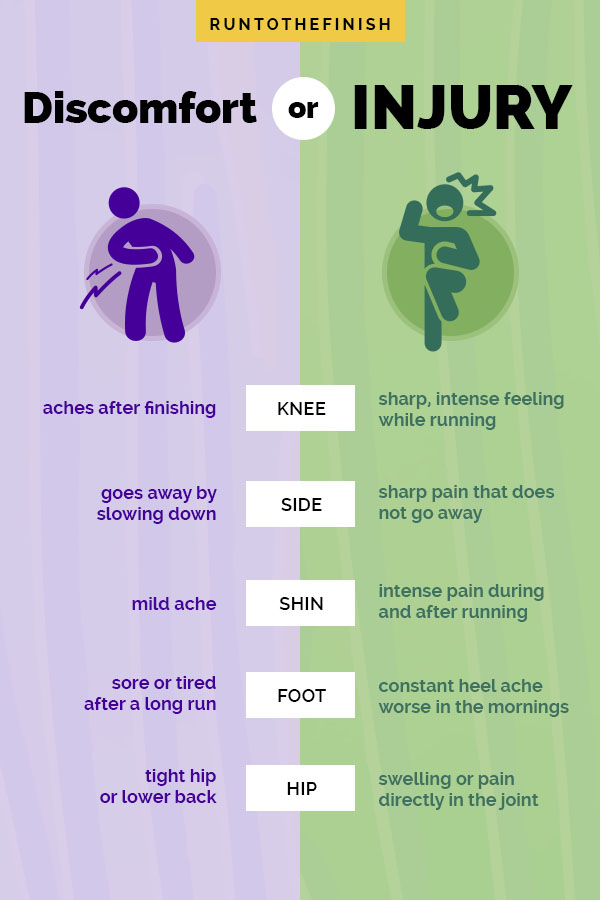Discomfort Vs Pain Runners Dilemma
In running, discomfort is a normal sensation, whereas pain indicates a potential injury that requires attention. Runners often face the dilemma of distinguishing between the two during their training sessions.
It is crucial to listen to your body and understand the difference between discomfort, which can be pushed through, and actual pain, which may lead to serious injury if ignored. By recognizing the signals your body is sending, you can make informed decisions to avoid potential setbacks and keep your running routine safe and effective.
This dilemma highlights the importance of knowing when to push yourself and when to prioritize your body’s well-being for long-term success in running.

Credit: www.drblakeshealingsole.com
The Difference Between Discomfort And Pain
As a runner, it’s crucial to distinguish between discomfort and pain to ensure your training remains effective and injury-free. Understanding the difference between the two can help you make informed decisions about when to push through and when to pull back. Let’s delve into the nuances of discomfort and pain for runners.
Understanding Discomfort
Discomfort during running is common and often stems from the body adapting to the physical demands of the activity. It can manifest as muscle fatigue, breathlessness, or mild soreness. Discomfort is a normal part of training and can even indicate that you are challenging your body in productive ways.
Understanding Pain
Pain, on the other hand, is a more serious warning sign. It goes beyond the discomfort that comes with physical exertion and can be sharp, persistent, or localized. Pain may be indicative of an underlying issue such as an injury, overuse, or poor form. Ignoring pain can lead to further injury and setbacks in your training.
Discomfort And Pain In Running
Running brings both discomfort and pain, creating a dilemma for many athletes. It’s crucial to recognize and differentiate between these sensations to prevent injuries and optimize performance.
Recognizing Discomfort In Running
- Listen to your body for signals of mild discomfort during runs.
- Recognize discomfort as a normal part of pushing your limits.
- Assess if the discomfort lessens after warming up.
Recognizing Pain In Running
- Identify sharp or stabbing sensations as potential signs of pain.
- Stop running if the pain increases with movement.
- Consult a medical professional if persistent pain is felt.
Discomfort And Performance
Discomfort vs. Pain: The Runner’s Dilemma
When it comes to running, understanding the difference between discomfort and pain is crucial. Finding that balance is essential for optimal performance.
How Discomfort Affects Performance
Discomfort during running is common and can vary from muscle soreness to fatigue. It affects performance as runners may struggle but can still push forward.
Proper discomfort management through training allows runners to build resilience and improve endurance.
The Role Of Pain In Performance
On the other hand, pain during running is a sign of potential injury. Ignoring pain can lead to long-term damage and hinder performance.
Runners must differentiate between discomfort and pain to prevent injuries and sustain their performance levels.
Managing Discomfort And Pain
Managing Discomfort and Pain is crucial for runners aiming to maintain a consistent training schedule and prevent injuries. Understanding the difference between discomfort and pain is essential for developing effective strategies. Both discomfort and pain should be managed thoughtfully to ensure runners can continue their training safely.
Strategies For Managing Discomfort
Runners can employ various strategies to manage discomfort during their training sessions. It’s essential to listen to the body and recognize the difference between discomfort and pain. Embracing the discomfort can help runners build mental resilience. Engaging in dynamic warm-up exercises and stretching routines before running can help alleviate discomfort during the workout. Additionally, ensuring proper hydration and nutrition can aid in managing discomfort.
Strategies For Managing Pain
When it comes to pain, runners mustn’t ignore persistent or severe pain. Recognizing the source of the pain is crucial to address it effectively. Utilizing the RICE (Rest, Ice, Compression, Elevation) method can be beneficial for managing acute pain. However, if the pain persists, it’s vital to seek professional medical evaluation and treatment. Incorporating strength training and cross-training activities can also help alleviate pain and prevent recurring injuries.
Seeking Professional Help
Runners often face a dilemma when deciding between discomfort and pain during training. Seeking professional help can provide the necessary guidance to differentiate between the two and prevent potential injuries while optimizing performance.
When To Seek Professional Help For Discomfort
As runners, we are no strangers to discomfort. It is a natural part of pushing ourselves to reach new goals and improve our performance. However, there may come a point when the discomfort we feel is more than just the usual soreness and fatigue. It’s essential to know when to seek professional help for discomfort to ensure we don’t overlook a potential injury that could worsen over time and hinder our progress.
If you experience any of the following symptoms during or after your runs, it is wise to consult a healthcare professional:
- If the discomfort is localized to one specific area and persists or worsens with each run.
- If the discomfort affects your performance and prevents you from completing your regular running routine.
- If the discomfort is accompanied by swelling, redness, or warmth in the affected area.
- If the discomfort causes sharp or shooting pains that are not relieved by rest or basic stretching.
When To Seek Professional Help For Pain
Pain is different from discomfort. It is a stronger and more persistent sensation that should not be ignored. While discomfort often accompanies a challenging run, pain is a clear indication that something is wrong. Running through pain can lead to further injury and long-term damage. Here are some signs that indicate it’s time to seek professional help for pain:
- If the pain is severe and prevents you from bearing weight on the affected area.
- If the pain persists even when you are at rest and not engaging in any physical activity.
- If the pain worsens with each run or progressively becomes more intense over time.
- If the pain is accompanied by visible deformity or swelling in the affected area.
Remember, your body knows best, and if it’s telling you something is wrong, it’s crucial to listen. Seeking professional help in a timely manner can prevent minor discomfort from turning into a major injury, allowing you to get back on track and continue pursuing your running goals.

Credit: www.runtothefinish.com

Credit: www.facebook.com
Frequently Asked Questions For Discomfort Vs Pain Runners Dilemma
Faq 1: What Is The Difference Between Discomfort And Pain For Runners?
Discomfort is a temporary, slight discomfort that runners may feel during their workout, whereas pain is a more intense and persistent sensation that may indicate an injury or overexertion.
Faq 2: How Can Runners Distinguish Between Discomfort And Pain?
Runners can distinguish between discomfort and pain by paying attention to the intensity, location, and duration of the sensation. Discomfort is often milder, more widespread, and temporary, while pain tends to be sharper, localized, and persistent.
Faq 3: What Should Runners Do If They Experience Pain While Running?
When runners experience pain while running, it’s important to listen to their bodies and take appropriate action. This may include reducing intensity, resting, stretching, or seeking medical advice if the pain persists or worsens.
Conclusion
As a runner, knowing the difference between discomfort and pain is essential for your overall performance and wellbeing. By recognizing early signs of potential injury, you can take proactive measures to prevent long-term damage and pursue your passion with confidence.
Embracing discomfort as a natural part of the process can lead to greater strength and resilience, allowing you to push your limits while staying mindful of your body’s signals. Remember, discomfort is your ally, but pain is the red flag signaling the need for a pause and reevaluation.
Keep running smart, listening to your body, and embracing the journey towards your goals.






